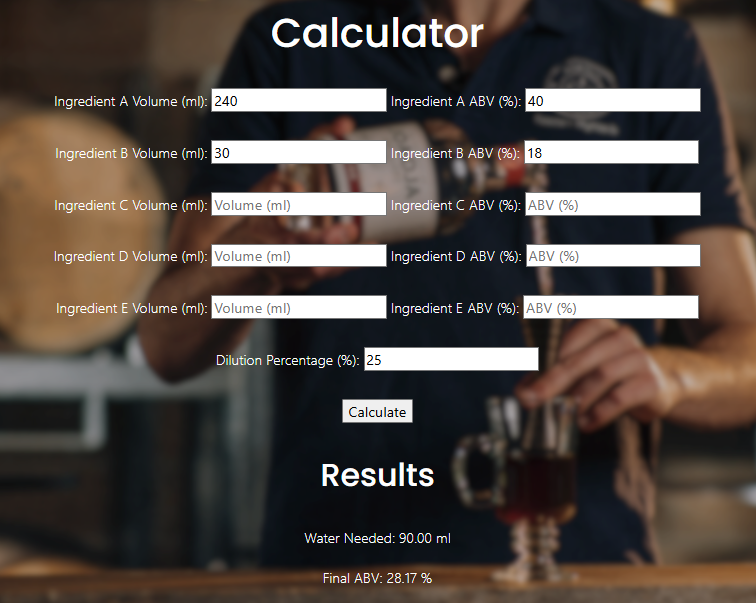Perfecting pre-batched cocktails!
How to use the Glass Half Full Batched Cocktail Dilution Calculator to craft the perfect batched cocktails.
Batched Cocktail Dilution Calculator- When you are looking to pre batch cocktails, this calculator takes the hardest part (doing the math) out of it!
There’s nothing better than the joy and convenience of a freezer door Martini or Manhattan, already pre-diluted, already chilled and ready to pour into your glass. To ensure you have the right dilution in your drink, this calculator will work out the volume of water needed in your batched cocktail to match your desired dilution percentage. The calculator works for drinks with up to 5 ingredients. Let’s say you were making a Martini, here is how it would go:
Ingredient A Volume: This is your gin. Enter in the volume of gin you are using in your batch. If you are basing it off the specs of 60ml gin and 7.5ml dry vermouth, you know that for the batch to be 2 serves you would need 120ml gin. 3 serves is 180ml, 4 serves is 240ml etc. Let’s say we wanted 4 serves, in Ingredient A Volume, enter 240ml.
Ingredient A ABV: Simple, just enter the ABV % in this field, in this example we are using a 40% ABV gin.
Ingredient B Volume: This is your dry vermouth. If we are making 4 serves, based off the specs it would be 7.5ml x 4. In this field, enter 30ml.
Ingredient B ABV: In this example, it is an 18% ABV dry vermouth.
Dilution Percentage: This is the percentage of water compared to your total volume in the final drink. The ‘Dilution Percentages For Cocktails’ section below will dive deeper into this. I find that for a dry, stiff Martini, the ideal ABV% usually sits around the high 20s when all is said and done. So in this example, the dilution percentage is 25%.
The calculator should look like this:
The results of the calculator show that 90ml of water is needed for a dilution percentage of 25%. The final ABV of this Martini with the water added will be 28.17%. Now pour your pre batched cocktail into a bottle, store in the freezer and once the drink hits at least -3°C you are ready to pour. Make sure you pour into a chilled glass as well!
Dilution Percentages For Cocktails: Depending on the style of drink, the way its served, and the ABV% of the combined ingredients, the perfect dilution percentage will vary.
27%-33%: This is the sweet spot for stirred cocktails that are served up, have a few ingredients that can hold up well against dilution, and might have a touch of sweetness to them. Think Martinez, Sazerac, Hanky Panky, Revolver. You should achieve a final ABV% in the low 20s.
22%-27%: This is the sweet spot for stirred cocktails that are served up, don’t have many ingredients and usually require a careful balance of dilution. A cocktail that should still be reasonably dry and stiff, yet relies on the delicate amount of water added to tie everything together. Think Manhattan, Martini, Rob Roy. You should achieve a final ABV% in the mid to high 20s.
20%-22%: In regards to pre batching cocktails, this is the ideal dilution percentage for stirred/built drinks that are served on ice. Because we would be pouring these over a large rock of ice, we want to initially dilute it a little less than the others. This allows the drink some wiggle room to dilute over time as the ice it is served on melts. Think Old Fashioned, Negroni, Boulevardier.
(Reference: p.130-p.131, Liquid Intelligence, Dave Arnold)
NOTE: The best part about cocktails is tailoring them specifically to your preferences. As you use the calculator, you might find that these ‘ideal’ dilution percentages and final ABV% might not be your preferred style. This is fine, take note of what you like and refer to that. You might like a Martini with a little less dilution, or maybe a Manhattan with a little more dilution, remember this for when you batch these cocktails next.
NOTE: Be mindful of the ABV% of the ingredients you use, a Martini with a 48% gin and a 22% vermouth will vary greatly from a Martini with a 40% gin and a 17% dry vermouth. Make the appropriate adjustments to the dilution percentage in instances like these.

